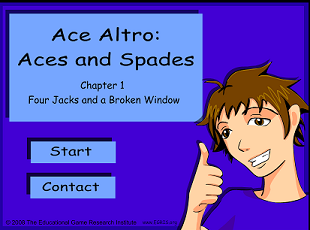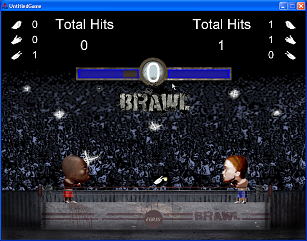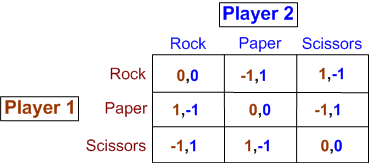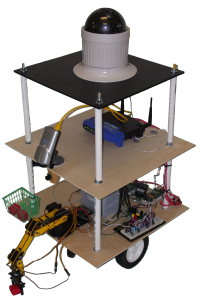


Research and Development Projects

Witnesses
may have speaking patterns (for example giving only ‘or’ or ‘and’
statements) that can be noticed by going through different cases, so
the long term success of the detective depends on the development of a
questioning strategy and the ability to categorize the set of suspects.
This game supplements instructions in logic: false, true
statements, truth tables, logical inferences, operations on sets,
categorization, conjecture making, proofs, etc.
Current Projects Include:
The current Educational Game Research Institute (Egris) R&D
activities include games and robotic projects design, implementation,
classroom testing, and presentations focused on math and science
education. These activities can be broken into:
1.
Creating
topic related, engaging, video game segments and robotics experiments
(using a game engine) that aid in teaching mathematics, computer
science, and the general sciences.
2.
Formally verifying the efficacy of these game segments and experiments in the post-secondary classroom environment.
3.
Presenting the material and activities to better determine appropriateness for different environments.
The concept of a “topic” related game segment:
Each
game segment will focus on a topic usable in multiple types of
courses. A few examples include the distributive law from algebra
used in many different science courses, the vector “dot” product used
in math, physics, and engineering, chemical equations and the periodic
table, and sorting concepts from math and computer science.
The
creation of these segments and experiments are a combined ongoing
effort using students, appropriate educators, and our small in-house
management team for the game design phase, and primarily students under
our management for game development and technical support.
The
formal verification of effectiveness, in the form of classroom
analysis, includes both student and faculty research teams under our
guidance. Much of the field work will occur during the school
year though some analysis will occur during the summers.

Ace Altro:
An online crime drama logic game, where the ultimate goal is to solve a
mystery, ‘Who done it?’. A player/detective can evaluate statements of
witnesses that are given in everyday language describing what they know
about the crime. Using symbolic logic the player translates the
statements into logical sentences and evaluates the outcome against the
collected evidence and the set of suspects. The complexity of the
statements, suspects’ diversity and evidence varies depending on the
age/level of the player.

Rock, Paper, Scissors (RPS)
RPS (also known as jan-ken-po, rochambeau or roshambo, ching-chang-wulla,
…), is based on the well known children’s game, where, with the
uniform probabilities (of 1/3), two players pick simultaneously a rock,
paper, or scissors:
If both
players pick the same object, there is a tie. This is a zero sum game
theory game (the only equilibrium is in mixed strategies).
The
game can be played with skill if the game extends over many sessions,
as a player can often recognize and exploit the non-random behavior of
an opponent. Then it is up to a player to determine the best competing
strategy. In this case, when playing against the computer, the
computer can create random strategies, each strategy lasting over many
sessions. The game supports probability and statistics
curriculum, data analysis, decision trees, strategic choices, etc.
·
Rock wins over scissors
·
Paper wins over rock
·
Scissors wins over paper

RPS Payoff Grid/ Scoring Table
Ice Race:
Ice Race, still in its infancy, is a race across a large body of water
with multiple obstacles played by one or more players. It
is used to demonstrate basic vector analysis. The player develops
a comfort level with vectors including vector addition, subtraction,
dot product and cross product.
Game Engine Robotics Project: This
activity uses an inexpensive Game Engine, a relational DBMS, and Rex, a
student - faculty created robot, to simultaneously both simulate and
control robots.
Near-term objective: Low-cost STEM (Science, Technology, Engineering, and Mathematics) teaching tools. Various
team based projects are used as teaching tools. The students
develop a comfort level with relational DBMSs, high level, embedded,
and real-time programming, vector analysis, kinematics, graph theory,
collision detection/resolution, AI, basic physics and mechanics, etc.
Monster Sort:
a combinatorial game that asks students to develop their own searching
and sorting strategies and compete with each other, or the computer
character, monster Gork, sorting and/or searching for numbered boxes.
Numbered boxes can be randomly or sequentially ordered. Several
parameters are evaluated: memory usage, steps required to complete,
complexity, etc. Students have full access to the data, and can make
their decisions to maximize the chances of success. This game
supplements school curricula in combinatorics, probability, algorithm
development, decision making strategies, computer programming, etc.
Simple example: Put boxes numbered 5,4,1,2,3 in increasing order.
Possible solution: move 5 to the side (store in the memory). Put
1 in the first spot, now the third spot is empty. Move 3 to the third
spot. Move 5 to the last spot. Put 4 to the side, move 2 to the second
spot, and move 4 from storage.
Number of steps: 7
Memory (storage) use: 1 unit
Depending on the initial distribution of numbers and the choice of
parameters (such as storage costs, number of steps, and time) the
student can hand craft an optimal solution, and, with experience, will
develop winning strategies.
When the student plays against Gork (the computer), Gork will use a
standard sorting technique such as Insertion Sort. How does that
compare to the student’s hand-crafted sort? Can the student
create an algorithmic sort (using a relatively simple algorithm
language) that is better than Gork’s standard sorting techniques?
What does better mean? What are the tradeoff’s in different
sorting strategies (e.g. Insertion Sort, Quick Sort, etc.) and the
student’s sorting algorithm?

Ultimate research objective: groups of 1 to 200 low-cost, multifunctional robots working together in:
| 1. |
Agriculture/environment
(fruit/vegetable picking; pest management; water/fertilizer
management; yard/garden maintenance, …) |
| 2. |
Industry (safety/security, parking patrol, inventory management, maintenance, …) |
| 3. |
The home (in-home care, …) |
Currently completing Phase II - Demonstrate a robot architecture (Rex) that supports:
| 1. |
Inexpensive research test bed and classroom STEM teaching tool |
| 2. |
Centrally managed manual and/or automated control via wifi |
| 3. |
Local level reflex autonomy and intelligence |
| 4. |
Independent “plug-and-play” sensors, motors, arms, … |
| 5. |
Multi-directional motion, multi DOF arm(s) and effector(s) |
| 6. |
Vision, ultrasound, GPS, … for environmental, positional and directional knowledge |
| 7. |
AI, FSMs, path finding, collision detection and avoidance |
| 8. |
RFID, solar, … |
| 9. |
Can support fault tolerance and/or redundancy
|







